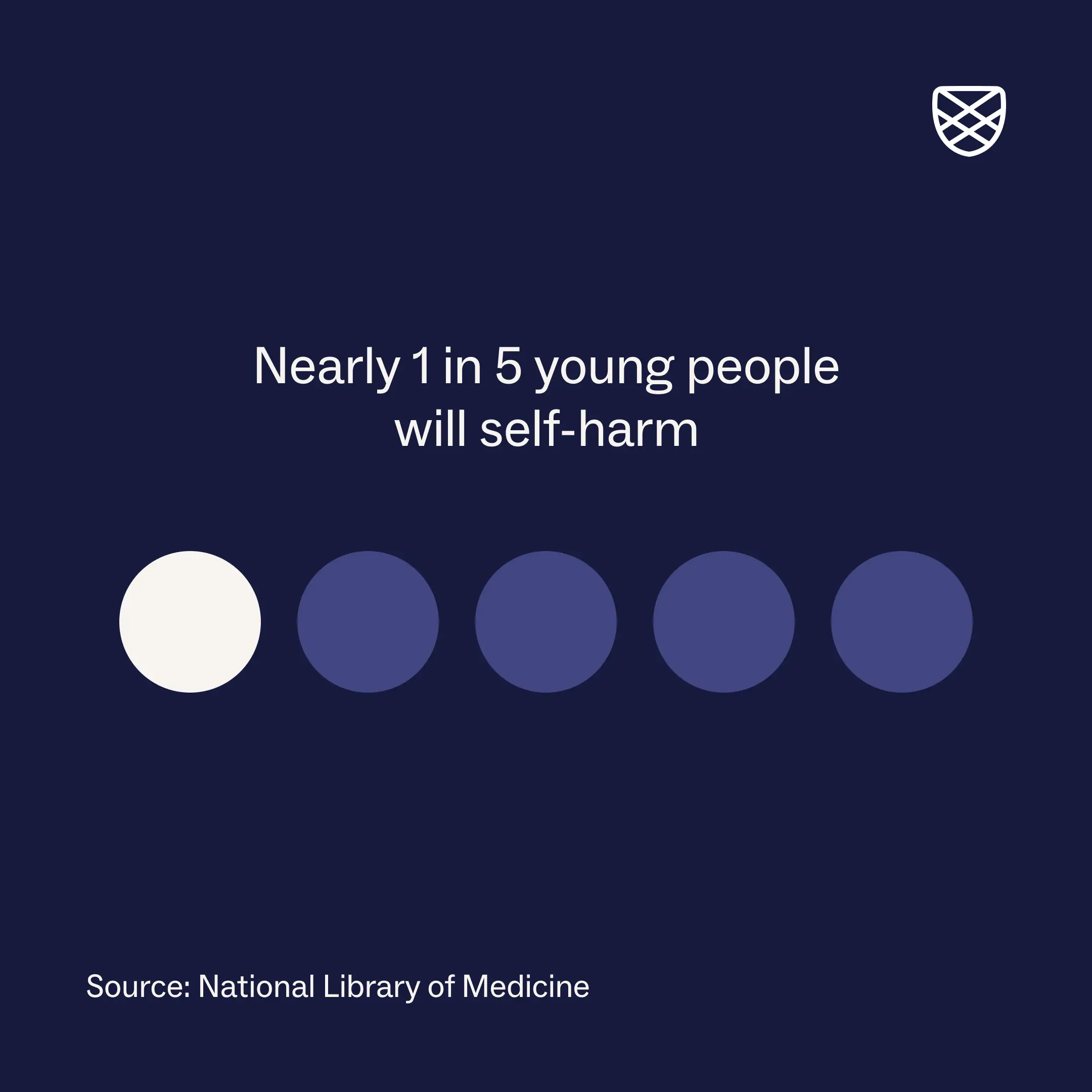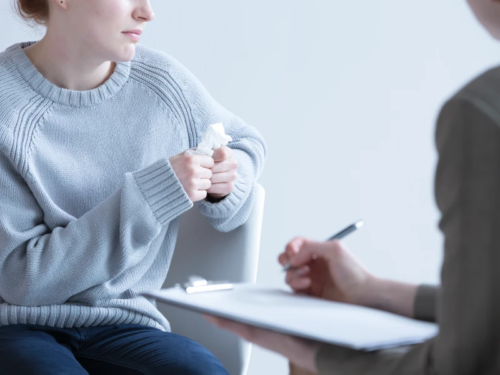
Table of Contents
Op-Ed: Just Because You’ve Self-Harmed Doesn’t Mean You’re Broken

Written By: Dr. Caroline Fenkel, DSW, LCSW
March 25, 2023
9 min.
In this thought-provoking op-ed, Caroline Fenkel, our Chief Clinical Officer, challenges the common misconception that self-harm is a sign of weakness or brokenness. With a compassionate and insightful perspective, Fenkel sheds light on the complexity of self-harm and advocates for understanding and support instead of stigmatization.
Learn more about our Clinical Review Process
Table of Contents
As a licensed clinician who works every day with teens and young adults navigating complex mental health issues, I know firsthand that the journey toward healing is not a linear one. It’s easy to feel broken and trapped by our past actions, especially when we’ve engaged in self-harm.
I’ve witnessed the shame and stigma that too often follows those who have self-harmed in the past. They struggle to feel understood, to feel safe sharing with others, and to move forward toward healing.
Unfortunately, our society often stigmatizes those who engage in self-harm, leaving young people feeling stuck in a never-ending cycle of shame and secrecy. The stigma of self-harm is rooted in a broad misunderstanding of the behavior as a sign of weakness or lack of control. This is simply not the case.
Many people are confused as to why someone would intentionally hurt themselves. However, it’s important to understand that self-harm is not an isolated behavior but rather a symptom of deeper underlying mental health issues, such as depression or anxiety.
To better understand this connection, consider a parallel example: swollen ankles as a sign of heart failure. While ankles may seem far away from the heart, they can be a sign of a larger issue. Similarly, self-harm is an outward expression of internal pain and distress, often associated with trauma, anxiety, or other serious mental health concerns. Rather than addressing the root cause of their problems, teens and young adults may turn to self-harm or substance use as a way to temporarily numb their emotions.

To draw a comparison: Have you ever experienced feelings of such intense overwhelm that you wanted to scream, shout, or even throw something at a wall? Or perhaps you’ve felt so helpless and disconnected from your life that you felt compelled to take action to regain control? These sensations are actually impulses that are also often the root cause of self-harming behaviors. When we acknowledge that we all have impulses as humans and seek relief in different ways, we lay the foundation for an empathetic and understanding conversation around self-harm that doesn’t contribute to shame-producing clichés:
“They’re just doing it for attention.”
“They don’t actually want to kill themselves.”
“They’re just doing it because they’re being goth.”
“Self-harm is such a girly thing.”
“They just like pain.”
“They must be suicidal.”
When we say things like this to or about people who self-harm (young people in particular), we are subjecting them to a never-ending cycle of shame and secrecy. Until we can collectively accept that self-harm is a treatable problem, this cycle will continue. It’s time to break down the walls that perpetuate self-harm stigma and provide young people with the support they need to heal. Most importantly, we need to continue to push for greater access to evidence-based care for young people everywhere who are struggling.
To any young person who has self-harmed, I want you to know that you are not alone. You deserve compassion and understanding, not judgment and shame. There are people who care about you and want to help you find a path toward healing. Self-harm does not define you, nor does it mean that you are inherently flawed, weak, or broken.
To parents, I urge you to approach your child’s self-harm with empathy and support. It can be tempting to react with anger or fear, but this only serves to reinforce feelings of shame and isolation. Instead, seek out resources and support for both yourself and your child.
Let’s work together to create a society that prioritizes mental health and supports those who struggle with self-harm. Let’s break down the stigma and recognize that with proper treatment and support, young people can and will heal.
You are not alone
Although it may feel like you’re the only one who’s struggling, the truth is that self-harm is more common than you think. It affects people from all walks of life, including young people who are bullied and rejected, members of the LGBTQIA+ community, individuals with an eating disorder or body image disorder, people who have low self-worth, individuals with depression or other mental health disorders, and those who have experienced trauma, neglect, or abuse. In fact, it’s estimated that nearly 1 in 5 young people will self-harm at some point.
If you’ve ever self-harmed, you know how hard it is to fight the urges and overwhelming emotions that tend to drive this behavior. Perhaps you’ve felt a sense of release or euphoria during or after self-harming, or maybe you’ve used self-harming behavior as an unhealthy outlet for negative emotions.
It is important to remember that you are not alone. Many people have walked in your shoes and have overcome self-harm.
Past actions do not define your future
Breaking the cycle of self-harm can seem like an insurmountable task, especially if regret over self-harm in the past weighs heavily on your mind. I understand the overwhelming nature of this struggle–I see you. But, self-harm is not a reflection of weakness or a lack of willpower. Instead, it’s a symptom of the pain and distress you are experiencing.
Remember: breaking the cycle of self-harm is possible with the right support and tools. Your past actions do not define your future. As a unique individual with your own set of experiences, emotions, and qualities, you have the power to shape your future.
As you work toward recovery, take things one step at a time, have patience, and be gentle with yourself. Your journey toward recovery will not be easy, but the outcome is worth it.
You are perfect the way you are
“Kintsugi,” also known as “kintsukuroi,” is a unique Japanese approach to repairing pottery. Areas that are broken or cracked are filled in with lacquer that has been mixed with gold, silver, platinum, or other precious materials. In this way, the finished product embraces flaws and imperfections rather than trying to disguise or discard them. This concept can be applied to self-harm recovery as well.
As you navigate through difficult times and overcome challenges, you’ll become stronger, more resilient, and more beautiful in your own unique way. If you’ve struggled with self-harm, it is more than possible to find hope and healing.
Rather than hiding from the past, embrace it as part of your journey to healing and wellness. You are resilient, beautiful, and strong. Imperfections, hard times, struggles, victories, and lessons make you you. If you have a history of self-harm, you’ve persevered through extraordinarily challenging mental health struggles. You are not a victim.
You are a survivor.

There are concrete actions you can take to avoid self-harm
Dealing with the urge to self-harm can be incredibly challenging. But by learning healthier coping mechanisms, you can create a happier, healthier life for yourself.
One way to begin is by taking the time to understand your triggers. Keeping a journal can help you recognize when certain people, feelings, or places trigger the urge to self-harm. Once you know what triggers you, you can start to create boundaries that reduce your risk of self-harm. It’s not always easy, but it’s worth it to create a safe environment for yourself. By learning healthier coping mechanisms – which I outline below – you can create a happier, healthier life for yourself.
Another important step is creating a safety plan. This means thinking ahead and preparing for when the urge to self-harm arises. You should remove all harmful or sharp objects from your personal space and replace them with safe alternatives. For instance, if you’ve cut your arms or wrists, you could use markers to draw on your arms or a piece of paper instead.
In addition to creating a safety plan, try to find activities that bring you joy and help you manage negative emotions. It can be as simple as taking a shower, playing with your dog, or going for a walk outside. Incorporating self-care practices into your routine can be a powerful tool for managing the urge to self-harm. Try reaching out to a friend for support, taking a few minutes to meditate and calm your mind, or engaging in some gentle stretching to release tension in your body. Explore what works best for you and make it a regular part of your self-care routine.
Another healthy coping mechanism you can try is the TIPP skill, which is a type of DBT (dialectical behavior therapy) skill. TIPP stands for temperature, intense exercise, paced breathing, and progressive muscle relaxation. Try to incorporate these practices into your self-harm safety plan:
- Temperature
Cold temperatures can help you relax. Try splashing your face with cold water, going outside for a walk in cool weather, or rubbing an ice cube on your hands or face for 30 seconds. Warmer temperatures can help you gain energy. Try taking a hot bath or shower, drinking warm tea, or using a heating pack. - Intense exercise
Exercise is a great way to relieve stress or high emotions and is something you do not need fancy equipment or a gym membership to complete. Try setting a timer for 10 minutes and going for a brisk walk, following along with an online home workout video, or stretching. However, please skip this step if you have an eating disorder or another medical condition that prevents you from working out. - Paced breathing
Try slowly breathing in through your nose and then breathing out through your mouth. Repeat for 1-2 minutes. - Progressive muscle relaxation
Starting from your head to your toes, work your way through each muscle group, ensuring they are relaxed. You’ll be surprised at how naturally tense some of the muscles in your body (such as your jaw or shoulders) are before you “tell” these muscles to relax.
A note to parents
As a parent of a child struggling with self-harm, you may be navigating several emotions at once: fear, shame, blame, depression, anxiety, anger, or even hopelessness.
“You are only as happy as your saddest child” is a sentiment that many parents feel and understand deeply. However, we want to reassure you that if your child has self-harmed, it’s not your fault. You are neither a failure as a parent nor is your child a failure at being your child.
Rather than assigning blame, think about self-harm as a symptom of a larger illness. Just as a fever is a symptom of an infection, self-harm may be a symptom of larger mental health issues such as depression, identity concerns, trouble with relationships, or trauma.
Your child is trying to survive, and if they have not developed healthy ways to cope with their feelings, self-harm may feel like their only option. Luckily, their history of self-harm does not define them now, nor will it define them in the future.
At the same time, it is essential to make sure that you take care of your personal mental health, whether that means opening up to family and friends, seeking therapy individually or as a family, participating in mindfulness or meditation techniques, and setting boundaries.
A collective call-to-action
It’s time to break down the walls that perpetuate the stigma of self-harm and provide young people with the support they need to heal. This includes ensuring that they have access to mental health resources and support systems. Parents, educators, healthcare providers, and policymakers all have a role to play in ending the stigma around self-harm and creating a culture of openness and acceptance.
It is our collective responsibility to create a society where individuals feel comfortable seeking help and talking about their struggles without fear of judgment or isolation. Together, let us work towards a future where mental health is a top priority and where all individuals feel supported and empowered to live their lives to the fullest.
Help is available.
If you or someone you know is experiencing a mental health emergency, please call the National Suicide & Crisis hotline at 988 or text the hotline by clicking this link.
At Charlie Health, our clinicians can help you end self-harming behavior through DBT skills and other virtual and individualized forms of therapy, supported groups, and more. Get started today.





